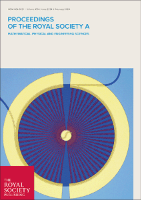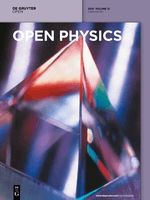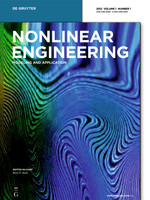
Top
Scope & Guideline
Exploring the Intersection of Theory and Application in Mathematics
Introduction
Aims and Scopes
- Machine Learning and AI Applications:
A significant portion of the journal's content focuses on the application of machine learning and artificial intelligence to solve complex problems in physics, biology, and engineering, reflecting a growing trend towards data-driven methodologies. - Dynamics and Control Systems:
Research on the dynamics, control, and synchronization of complex systems, including neural networks, robotic systems, and fluid dynamics, is prominently featured, indicating an emphasis on both theoretical exploration and practical implementation. - Nanofluid and Thermal Dynamics:
The journal publishes extensive studies on nanofluid behaviors and thermal dynamics, exploring their applications in energy systems, biomedical engineering, and environmental science, highlighting the relevance of nanotechnology in modern research. - Epidemiological Modeling:
With the recent global health challenges, the journal includes a substantial number of papers on mathematical modeling of infectious diseases, particularly COVID-19, showcasing the importance of quantitative analysis in public health. - Astrophysics and Particle Physics:
The journal addresses foundational questions in particle physics and astrophysics, including studies on neutrinos, dark matter, and cosmic phenomena, indicating a strong commitment to fundamental scientific inquiries. - Fractional Calculus and Complex Systems:
Papers exploring fractional calculus and its applications in various complex systems are prevalent, demonstrating the journal's focus on advanced mathematical techniques for modeling real-world phenomena.
Trending and Emerging
- Quantum Computing and Quantum Technologies:
Research related to quantum computing, quantum information science, and applications of quantum technologies is rapidly increasing, showcasing the journal's commitment to cutting-edge advancements in this area. - Multistability and Chaotic Systems:
There is a growing interest in the exploration of multistability and chaotic behaviors in various systems, indicating a trend towards understanding complex dynamics and their applications in fields such as neuroscience and engineering. - Sustainable Energy and Environmental Dynamics:
Papers addressing sustainable energy solutions and environmental dynamics, particularly those integrating nanotechnology and advanced materials, are becoming more prominent, reflecting a global emphasis on sustainability. - Neuroscience and Brain Dynamics:
With a notable increase in research on neural networks and brain dynamics, the journal highlights a trend towards understanding complex biological systems and their implications for health and technology. - Advanced Materials and Nanotechnology:
The journal is increasingly featuring research on advanced materials, particularly nanomaterials and their applications in various fields, indicating a strong trend towards innovation in material science.
Declining or Waning
- Classical Mechanics and Traditional Physics:
There has been a noticeable decline in papers strictly focused on classical mechanics, as researchers increasingly gravitate towards complex systems and interdisciplinary studies that incorporate modern technologies and theoretical frameworks. - Static Models in Epidemiology:
The focus on static or deterministic models in epidemiology has waned, with more researchers favoring dynamic and stochastic approaches that better reflect the complexities of disease spread and control. - Traditional Imaging Techniques:
Research centered around traditional imaging techniques has seen a decrease as newer, more advanced imaging technologies and methodologies gain prominence and attention in the scientific community.
Similar Journals

Journal of Systems Science & Complexity
Exploring the Frontiers of Systems Science and Complexity.The Journal of Systems Science & Complexity, published by SPRINGER HEIDELBERG, stands as a leading forum for innovative research in the fields of computer science and information systems. With an ISSN of 1009-6124 and an E-ISSN of 1559-7067, this journal has established itself within the academic community, garnering a commendable impact factor that reflects its influential contributions. Operating from 2006 and continuing through 2024, it is categorized in the Q2 quartile for both Computer Science (Miscellaneous) and Information Systems, indicating its quality and relevance. Recognized within Scopus rankings, it places 52nd out of 133 in its specific field, affirming its significance in advancing systems science discussions. Researchers and professionals will find a wealth of knowledge through rigorous peer-reviewed articles that explore complex systems and their applications, enabling readers to stay at the forefront of technological advancements and interdisciplinary collaboration.

PROCEEDINGS OF THE ROYAL SOCIETY A-MATHEMATICAL PHYSICAL AND ENGINEERING SCIENCES
Elevating Knowledge Through Rigorous Scientific Exploration.PROCEEDINGS OF THE ROYAL SOCIETY A-MATHEMATICAL PHYSICAL AND ENGINEERING SCIENCES is a prestigious academic journal published by the Royal Society in the United Kingdom, dedicated to the dissemination of high-quality research in the fields of Mathematics, Engineering, and Physics. With an esteemed impact factor and ranked in the top quartiles (Q1) across various categories, this journal stands out as a leading source of innovative findings and critical discussions within the global scientific community. Researchers benefit from its comprehensive coverage that spans from theoretical explorations to practical applications, and the journal plays a crucial role in advancing knowledge and fostering interdisciplinary collaboration. Although it does not currently offer Open Access options, its influence is underscored by notable Scopus rankings, evidencing its significant contribution to the fields it represents. Located at 6-9 Carlton House Terrace, London SW1Y 5AG, England, the journal continues to be a cornerstone for scholars seeking to publish impactful research and stay informed on the latest advancements in science and engineering.

Open Physics
Unlocking the potential of open research in physics and astronomy.Open Physics, published by DE GRUYTER POLAND SP Z O O, is a leading open access journal dedicated to advancing the field of physics and astronomy. Established in 2015, this journal not only promotes the dissemination of innovative research but also emphasizes accessibility, allowing researchers, professionals, and students alike to freely engage with the latest advancements in various physics disciplines. With an impact factor that positions it within the Q3 category of the broader physics and astronomy community, Open Physics currently holds a respectable ranking of #102 out of 243 journals in its field according to Scopus, placing it in the 58th percentile. The journal encourages rigorous scholarship and the sharing of knowledge within a collaborative environment. Based in Germany, with its editorial office located in Warsaw, Poland, Open Physics is dedicated to fostering international dialogue and interdisciplinary research, making it an essential resource for those shaping the future of physical sciences.

Applications and Applied Mathematics-An International Journal
Innovating Mathematics: From Theory to Practical ImpactApplications and Applied Mathematics-An International Journal, published by Prairie View A & M University, Department of Mathematics, serves as a pivotal platform for disseminating high-quality research in the interconnected realms of mathematics and its practical applications. With its ISSN 1932-9466, this journal invites contributions focused on novel methodologies, theoretical advancements, and empirical studies that underscore the vital role of mathematics across diverse disciplines. Although it currently does not offer open access options, the journal is committed to advancing knowledge and fostering collaboration among researchers, professionals, and students seeking to explore the application of mathematical concepts to real-world problems. As it gains prominence in the academic community, Applications and Applied Mathematics aspires to maintain a robust editorial process to ensure the rigor and integrity of published research, subsequently contributing to the advancement of both theoretical and applied mathematics.

Advances in Mathematical Physics
Innovating Research for Tomorrow's TheoriesAdvances in Mathematical Physics is a premier open-access journal published by HINDAWI LTD, dedicated to the dissemination of research in the fields of applied mathematics and physics. With its ISSN 1687-9120 and E-ISSN 1687-9139, this journal has been a vital platform for innovative studies since its inception in 2009, fostering a collaborative environment for researchers and professionals alike. The journal features a wide range of topics, including but not limited to mathematical models, computational physics, and interdisciplinary applications, thus attracting a diverse readership. Ranked in the Q3 quartile for both Applied Mathematics and Physics and Astronomy, it serves as a significant resource for academics looking to explore cutting-edge developments and theoretical advancements. With an emphasis on open accessibility, Advances in Mathematical Physics ensures that research findings are readily available to the global academic community, leveling the playing field for emerging scholars and seasoned researchers. By consistently showcasing high-quality manuscripts, the journal contributes substantially to the fields of mathematics and physics, encouraging scholarly dialogue and advancing knowledge across a myriad of applications.

INTERNATIONAL JOURNAL OF MODELLING AND SIMULATION
Empowering Research Through Simulation ExcellenceINTERNATIONAL JOURNAL OF MODELLING AND SIMULATION, published by Taylor & Francis Inc, stands as a leading platform for the dissemination of high-quality research in the fields of modeling and simulation across various engineering disciplines. With an ISSN of 0228-6203 and an E-ISSN of 1925-7082, this esteemed journal has been actively contributing to the academic community since 1996. It enjoys a commendable reputation, ranked in Q2 across numerous categories including Electrical and Electronic Engineering, Engineering (miscellaneous), and Modeling and Simulation, reflecting its vital presence in the academic landscape. The impact factor has not been specified, but its impressive Scopus rankings demonstrate its significance, particularly in General Mathematics and various engineering fields, placing it within the 83rd percentile and above. With a broad scope that encompasses industrial applications and theoretical advancements, the journal aims to foster innovations that drive progress in technology and data analysis. While it is a traditional subscription-based journal, researchers and practitioners are highly encouraged to submit their findings to contribute to the ongoing dialogue in this dynamic field, making it a valuable resource for both established experts and aspiring scholars.

Communications in Nonlinear Science and Numerical Simulation
Driving Insights in Nonlinear Phenomena and Numerical InnovationCommunications in Nonlinear Science and Numerical Simulation is a premier journal published by ELSEVIER, dedicated to advancing the field of applied mathematics and numerical analysis. With an impressive Q1 ranking in categories such as Applied Mathematics, Modeling and Simulation, and Numerical Analysis, this journal stands out as a vital resource for researchers and professionals alike. Established in 1996, it consistently features high-quality research contributions, and its current Scopus rankings highlight its influence and relevance in the field, placing it in the 92nd percentile for Applied Mathematics and 91st for Numerical Analysis. The journal not only disseminates pivotal findings but also encourages the exploration of nonlinear phenomena and innovative numerical methods. Scholars engaged in computational methodologies and modeling can benefit from its rigorous peer-reviewed articles, fostering collaboration and knowledge exchange within the academic community. Located in the Netherlands, Communications in Nonlinear Science and Numerical Simulation remains a touchstone for cutting-edge research through effective dissemination of ideas that shape future mathematical landscapes.

Acta Mechanica et Automatica
Exploring the Frontiers of Mechanical and Control EngineeringActa Mechanica et Automatica is a leading open-access journal published by SCIENDO, dedicated to the dynamic fields of Mechanical Engineering and Control and Systems Engineering. Since its inception in 2012, this journal has provided a vital platform for researchers and professionals to disseminate innovative findings and advances within these disciplines, boasting a convergence of years up to 2024. Based in Warsaw, Poland, the journal has embraced open access since 2013, ensuring broad dissemination of knowledge for the academic community globally. With a current Scopus ranking placing it in the 25th to 31st percentile among its peers, it plays an essential role in fostering scholarly communication and collaboration. The objectives of Acta Mechanica et Automatica include promoting original research, facilitating dialogue between disciplines, and enhancing the understanding of complex mechanical and control systems. This journal is invaluable for researchers looking to explore cutting-edge methodologies, theories, and applications in engineering.

Journal of Physics-Complexity
Fostering Interdisciplinary Insights in Physics and Information ScienceThe Journal of Physics-Complexity, published by IOP Publishing Ltd, is a premier open access journal that has been making significant strides in the fields of Artificial Intelligence, Computer Networks and Communications, Computer Science Applications, and Information Systems since its establishment in 2020. Operating from the United Kingdom, this journal aims to foster interdisciplinary research that bridges theoretical and applied aspects of complexity science. With an admirable Q2 ranking in four prestigious categories and a Scopus ranking indicating it holds a solid position within its fields, this journal caters to a diverse audience of researchers, professionals, and students eager to explore the intricacies of complex systems. Its open access model ensures that groundbreaking research is readily available to the global community, thereby enhancing the dissemination of knowledge and information. As it converges towards 2024, the Journal of Physics-Complexity is poised to expand its influence, inviting innovative contributions that challenge conventional thinking and push the boundaries of scientific discovery.

Nonlinear Engineering - Modeling and Application
Pioneering Research for a Dynamic Engineering LandscapeNonlinear Engineering - Modeling and Application is a premier journal dedicated to advancing the fields of engineering, modeling, and simulation, published by De Gruyter Poland Sp. z o.o. since 2012. With an impressive impact factor reflected in its prestigious rankings—Q2 in Chemical Engineering and Miscellaneous Engineering and Q3 in Computer Networks and Communications—this journal serves as an invaluable resource for researchers and practitioners seeking to explore the intricacies of nonlinear systems and their applications. As an Open Access journal since 2019, it ensures that groundbreaking research is readily available to the global community, fostering collaboration and innovation. Situated at the forefront of its field, Nonlinear Engineering provides high-quality, peer-reviewed articles that contribute to understanding complex phenomena in various engineering disciplines, making it an essential publication for those eager to stay on the cutting edge of technology and research.